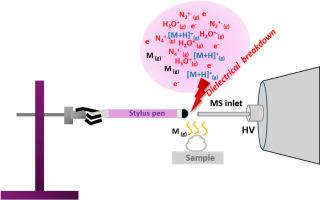基于触控笔的环境电离质谱仪用于分析液体、粘性和固体样品中的挥发性物质和半挥发性物质
IF 6
2区 化学
Q1 CHEMISTRY, ANALYTICAL
引用次数: 0
摘要
环境电离质谱法(MS)因其简单、易操作而备受关注。非接触或场致电离是环境电离技术的一种。在这种方法中,不需要在电离辅助衬底上直接电接触或附加电压。相反,电场是由施加在质谱仪孔板上的高电压引起的。然而,仍然需要探索紧凑和易于获得的电离衬底,用于场致电离技术。结果:通常用于触摸屏的触控笔被用作分析挥发性和半挥发性有机化合物的离子源。当触笔靠近质谱仪入口并施加高压时,位于质谱仪入口下方的挥发性和半挥发性化合物产生的蒸汽被电离。半挥发物和挥发物的检出限在mM到几百nM之间,这取决于这些分析物的蒸汽压和化学结构。此外,在实际样品中发现的半挥发性化合物可以使用我们的方法直接检测。此外,我们还演示了使用触控笔作为采样探针从玻璃载玻片表面提取样品的可行性,然后将笔靠近质谱仪的入口,使用我们的方法进行直接的质谱分析。意义:该方法为分析环境条件下的挥发物和半挥发物提供了一种简便易行的方法。通过在质谱仪入口附近放置一支手写笔,可以很容易地在质谱仪入口附近发生分析物蒸汽的电离,突出了该方法的简单性作为主要优点。因此,这种方法可以很容易地与具有高电压施加到其孔的质谱仪相结合。本文章由计算机程序翻译,如有差异,请以英文原文为准。


Stylus pen-based ambient ionization mass spectrometry for the analysis of volatiles and semivolatiles from liquid, viscous, and solid samples
Background
Ambient ionization mass spectrometry (MS) has attracted significant attention due to its simplicity and ease of operation. Contactless, or field-induced, ionization is one of the ambient ionization techniques. In this approach, no direct electrical contact or additional voltage is required on the ionization-assisted substrate. Instead, the electric field is induced by the high voltage applied to the orifice of the mass spectrometer. However, there remains a demand for exploring compact and readily available ionization substrates for use in field-induced ionization techniques. Results: A stylus pen, typically used for touch screens, is used as an ion source for analyzing volatile and semivolatile organic compounds. Vapors originating from volatile and semivolatile compounds placed underneath the inlet of the mass spectrometer were ionized when the stylus pen was positioned near the inlet, which is applied with a high voltage. The limits of detection for semivolatiles and volatiles were in the range of mM to a few hundred nM, depending on the vapor pressure and chemical structures of these analytes. Additionally, semivolatile compounds found in real samples could be directly detected using our method. Moreover, we also demonstrated the feasibility of using the stylus pen as the sampling probe to pick up samples from the surface of a glass slide, followed by bringing the pen close to the inlet of the mass spectrometer for direct MS analysis using our approach. Significance: The developed method provides a straightforward approach for analyzing volatiles and semi-volatiles under ambient conditions. Ionization of the analyte vapor near the mass spectrometer inlet can readily occur by placing a stylus pen close to the inlet, highlighting simplicity as the main advantage of the developed method. Consequently, this method can be easily coupled with a mass spectrometer that has a high voltage applied to its orifice.
求助全文
通过发布文献求助,成功后即可免费获取论文全文。
去求助
来源期刊

Analytica Chimica Acta
化学-分析化学
CiteScore
10.40
自引率
6.50%
发文量
1081
审稿时长
38 days
期刊介绍:
Analytica Chimica Acta has an open access mirror journal Analytica Chimica Acta: X, sharing the same aims and scope, editorial team, submission system and rigorous peer review.
Analytica Chimica Acta provides a forum for the rapid publication of original research, and critical, comprehensive reviews dealing with all aspects of fundamental and applied modern analytical chemistry. The journal welcomes the submission of research papers which report studies concerning the development of new and significant analytical methodologies. In determining the suitability of submitted articles for publication, particular scrutiny will be placed on the degree of novelty and impact of the research and the extent to which it adds to the existing body of knowledge in analytical chemistry.
 求助内容:
求助内容: 应助结果提醒方式:
应助结果提醒方式:


